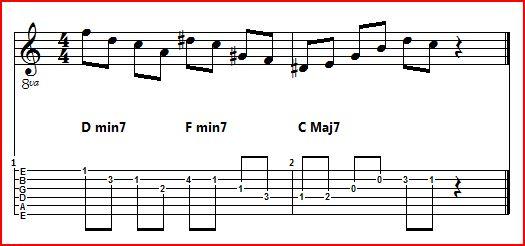
Lesson 32
Notes to Lesson 32
Lesson 32 gives us a breather! No exercises to learn, just learn Mickey's analysis of each Blues.
Wow! Whoa! Just a second! Mickey asks us to now study the three Blues from Lesson 31 in all keys. So now we need to work on Db and Eb. After seven months of working with these keys, that's no big deal!
Mickey tells us that Lesson 31 is the most important one in the soloing section because all the succeeding lessons are based on this one. That's quite an endorsement.
Blues #1- Mickey tells us what we learned in Lesson 21: sometimes Measures 9 and 10 of a Blues is the V7 going to the IV7. Note that you can force either chord progression, V7 - IV7 or ii7 to V7, against the melody and it works.
Blues #2- Mickey's just reviewing the Harmony Lesson we learned in Lessons 19 and 20. That is, a iii7 can freely substitute for a I Maj7. In fact, it's the upper 4 notes to a I Maj9 chord. Mickey also states that ii7 to iv7 runs work great against V super altered chords, like V13b5b9 and V7#5b9. Just so we don't get lost in the Roman numerals, let's relate that to everyone's favorite key, C: runs of D min7 going to F min7 work against our super colored V chords like G13b5b9 and G7#5b9. Why? A D min7 comprises the notes D, F, A, C. As we may remember from our earlier harmony lessons, these notes are the top 4 notes of a G11 chord. An F min7 comprises F, Ab, C, Eb. F and C we covered in D min7. The Ab is a b9 in a G dominant chord, and Eb (which is also a D#) is a #5.

ii7 to iv7 to I Maj7
Click on this link to hear this as a MIDI sound file with rhythm guitar: ii7 to iv7 to I Maj7 . If you have problems with your audio program listening to a MIDI file, a free download of a great simple audio and video program (it works great with Flash video formats as a bonus) is available at www.gomplayer.com.
In fact, play an F min7 chord, but with a G in the bass and then just lift that 1/2 barre on the 1st fret. That gives us a G11b9 going to a G13.
G11b9 to G13 to C Maj6
Let's listen to it: G11b9 - G13 - C Maj6 . Sound familiar? If not, buy yourself a CD of the greatest hits of Les Paul and Mary Ford.
These tricks work in any style of music.
Blues #3- Mickey introduces us to a "riff run" by saying that it is, but without telling us what it is. A riff is a catchy little phrase that can be made of most anything: scales, arpeggios, blue notes, and can be forced against any harmony in the key. Some guitarists have made a career out of just playing riffs, while others say that it hurts your creativity and we should avoid them. Fact is, all guitarists, including us, use riffs regularly, just as you hear repeating elements in the great composers like Gershwin, Ellington, Rodgers, Porter, and Berlin. In just a few lessons, Mickey will give us a number of riff runs to memorize and use and will ask us to create our own. I'm going to recommend that you go on a Riff Expedition and find your favorite riffs by your favorite professional guitarists and transcribe them for your use in later lessons. In the coming lessons I'll try to share some of my favorite riffs.
Oh by the way- why don't we use this opportunity to write chord substitutions for five of our favorite tunes. Here's five of mine:
1. Here's That Rainy Day
2. I Love You for Sentimental Reasons
3. Limehouse Blues (which really isn't a Blues at all!)
4. Mood Indigo
5. Lover (Wasn't this originally in 3/4 time?)
Just keep it FUN!